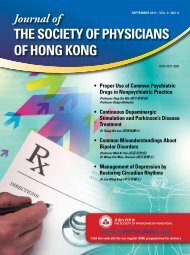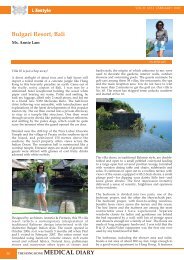the Society of Physicians of Hong Kong
THE SOCIETY OF PHYSICIANS OF HONG KONG
THE SOCIETY OF PHYSICIANS OF HONG KONG
- No tags were found...
Create successful ePaper yourself
Turn your PDF publications into a flip-book with our unique Google optimized e-Paper software.
Table. Nutritional additives in infant formula<br />
1. Long-chain<br />
polyunsaturated<br />
fatty acids<br />
(LCPUFA –<br />
ARA & DHA)<br />
Rationale Potential specific benefits Unresolved issues Potential disadvantages<br />
• Unmodified formula<br />
contains only <strong>the</strong> precursors,<br />
but not ARA and<br />
DHA<br />
• Present in large quantities<br />
in brain and retina<br />
• Potential visual and neurodevelopmental<br />
benefits<br />
• Little evidence from RCT to support<br />
benefit for neurodevelopment <strong>of</strong> term<br />
infants, but may be beneficial to preterm<br />
infants who have a greater demand<br />
• No gold standard for ideal<br />
amount and ratio <strong>of</strong> DHA/<br />
ARA<br />
• Insufficient evidence to<br />
determine true functional<br />
benefit and safety pr<strong>of</strong>ile<br />
• Possible adverse effect due<br />
to imbalance in intake <strong>of</strong><br />
DHA and ARA<br />
• Theoretical risks <strong>of</strong><br />
increased infection and<br />
susceptibility to oxidant<br />
injury<br />
2. Nucleotides<br />
and nucleic<br />
acid<br />
• Semiessential nutrient; de<br />
novo syn<strong>the</strong>sis from nonessential<br />
precursors<br />
demands a metabolically<br />
costly pathway<br />
• Dietary nucleotides may<br />
be important in tissues<br />
with rapid turnover (eg,<br />
bone marrow, leucocytes<br />
and intestinal mucosa<br />
[neonatal gut has complete<br />
replacement <strong>of</strong> enteric epi<strong>the</strong>lium<br />
in around 5 days])<br />
• Enhance growth and differentiation<br />
<strong>of</strong> gastrointestinal tract (eg, speed up<br />
recovery from intestinal illnesses such as<br />
necrotizing enterocolitis, diarrhoea, state<br />
<strong>of</strong> malnutrition)<br />
• Upregulate cellular and humoral immunity,<br />
decrease incidence <strong>of</strong> diarrhoea,<br />
fewer URTI in malnourished children,<br />
higher antibody response to immunization<br />
• Promote growth: RCT on term SGA<br />
infants showed better catch-up (height,<br />
body weight and head circumference) in<br />
supplemented group in <strong>the</strong> first 6 months<br />
• Very few studies on actual<br />
reduction <strong>of</strong> infection with<br />
fortification <strong>of</strong> nucleotides<br />
in infant formula<br />
• Benefits <strong>of</strong> nucleotide<br />
supplementation remains<br />
controversial in term infants<br />
• No adverse effects have<br />
been reported<br />
• Nucleotide-supplemented<br />
infant formulas are currently<br />
considered safe<br />
3. Taurine • Most abundant free amino<br />
acid in human milk; low in<br />
cow’s milk and absent in<br />
unsupplemented soy milk<br />
• High concentration in brain<br />
− several times higher in<br />
newborns than adults<br />
• Taurine deficiency in cats associated<br />
with retinal degeneration<br />
• Prolonged taurine-free parenteral<br />
nutrition resulted in retinal degeneration,<br />
which was reversed with taurine supplementation<br />
• Premature infants on taurinesupplemented<br />
formula has more mature<br />
auditory brainstem evoked potential<br />
• Lower plasma taurine in preterm infants<br />
was associated with lower scores on<br />
<strong>the</strong> Bayley Mental Development Index<br />
at 18 months and <strong>the</strong> WISC-R arithmetic<br />
subtest at 7 years<br />
• Cochrane systematic<br />
reviews <strong>of</strong> 9 small RCT<br />
showed no significant<br />
effects on growth and<br />
development with taurine<br />
supplementation in preterm<br />
or low birth weight infants<br />
• No adverse effects demonstrated<br />
• Taurine is currently added<br />
to all infant formulas and<br />
soy protein-based formulas<br />
worldwide<br />
ARA = arachidonic acid; DHA = docosahexaenoic acid; RCT = randomized controlled trials; SGA = small for gestational age; URTI = upper respiratory tract infections; WISC-R = Wechsler Intelligence Scale for Children<br />
revised edition<br />
effects are unlikely to be mimicked by<br />
simple addition <strong>of</strong> isolated factors to <strong>the</strong><br />
cow’s milk formula. Fur<strong>the</strong>rmore, <strong>the</strong>re<br />
are issues <strong>of</strong> bioavailability, loss through<br />
processing, shelf-life, and <strong>the</strong> added cost<br />
associated with <strong>the</strong>se modifications.<br />
Infant formula should aim at providing<br />
<strong>the</strong> best alternative to breast milk for<br />
infants by adapting its content so that <strong>the</strong><br />
physiological and functional outcomes <strong>of</strong><br />
formula-fed infants are closer to those <strong>of</strong><br />
breast-fed infants in terms <strong>of</strong> growth and<br />
development.<br />
Special Formulas<br />
Protein Hydrolysate Formulas<br />
Protein hydrolysate formulas or extensively<br />
hydrolyzed formulas (eHF) refer to<br />
formulas with <strong>the</strong> protein component consisting<br />
<strong>of</strong> extensively hydrolyzed proteins<br />
derived from cow’s milk, in which most<br />
<strong>of</strong> <strong>the</strong> nitrogen is in <strong>the</strong> form <strong>of</strong> free<br />
amino acids and peptides








